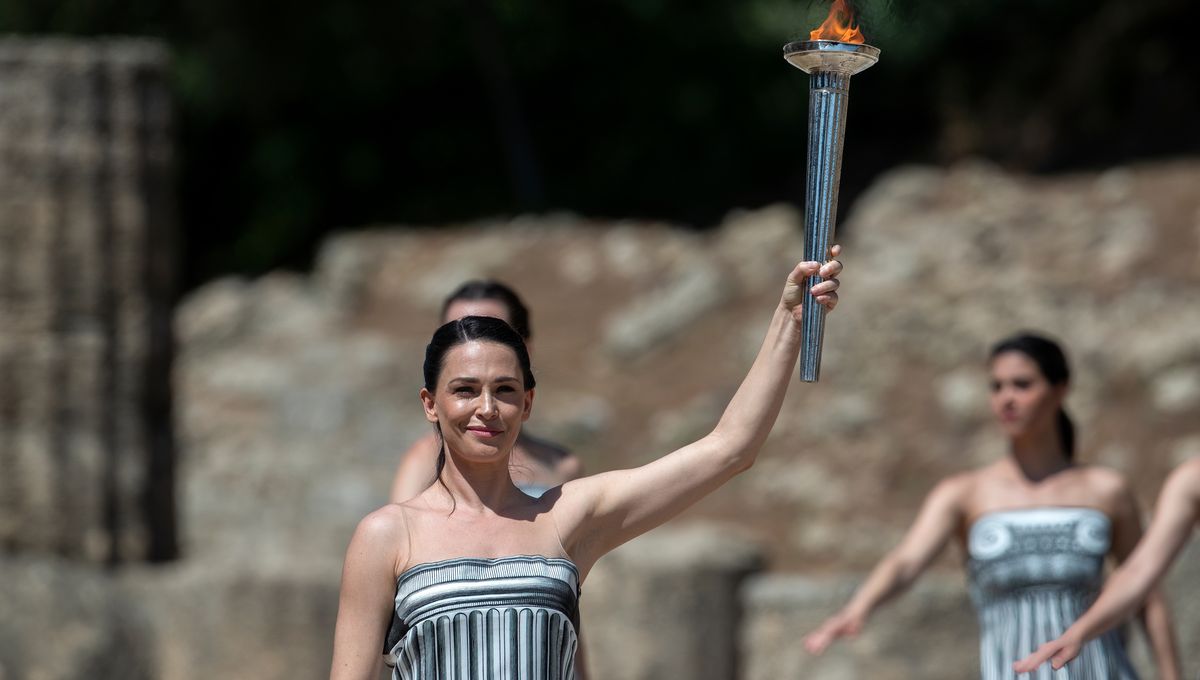
On Friday, July 26, the Olympic torch arrived in Paris and was used to ceremoniously light the Olympic Cauldron, which will continue to illuminate the skies throughout the Olympic Games. It’s quite the spectacle, but its origins have some unexpected twists.
According to The Olympic Museum, “The Olympic Torch Relay is now a powerful symbol of understanding and brotherhood among peoples.”
Per tradition, the torch was lit in Olympia, Greece, on April 16, and from there it was relayed for three months before arriving in Paris. Its journey was positively chaotic. It spent eight days bouncing around Greece before leaving from Athens on a ship to Marseille, where it then started doodling all over France, paying everyone a visit. You’ve got to wonder what the few regions that were skipped did to deserve that.
This is not how it used to be. It might seem like the continuation of some beautiful ancient tradition, but the whole thing is less than 100 years old. The Olympic flame itself was lit for the first time at the Ninth Olympic Games in Amsterdam in 1928, where “a high flame would indicate for miles around where in Amsterdam the Olympic Games were being held” (according to the Official Olympic Report 1928).
The idea of a flame was inspired by the ancient Greek tradition of keeping in front of their temples perpetual fires lit by the heat of the sun. Even today, the Olympic Flame is lit in a ceremony in Olympia. The rays of the sun are captured and reflected inside a parabolic mirror (a modern version of the skaphia) generating enough heat to light the fire (although cloudy weather meant 2024’s ceremony had to rely on a backup flame).
The idea to carry that flame from Olympia all the way to where the Games were being held was first proposed for the 1936 Games held in Berlin. Yes, that’s right, 1936 “Third Reich” Germany.
The planning and preparation for the relay alone took a whole two years. It was such an elaborate choreography for a display of German organization that in their official report they dedicate 25 pages to describing it in detail (the full report is 1,000 pages including all the results – quite a riveting read).
Instead of the chaotic scribble that the relay did in 2024, in 1936 the torch actually traveled continuously from Olympia to Berlin for 12 days. It was a journey of 3,187 kilometers (1,980 miles), where approximately every kilometer was covered by a different runner. Each with their own torch. Apparently just getting all those thousands of torches through customs in the different countries was a nightmare.
There were more than 3,000 runners, all from the different countries that the torch was going to pass through and “All were conscious of the symbolic significance of this relay run, which represented a link, so to speak, between the ancient and the modern Festival,” according to the Official Olympic Report 1936.
Then there was the problem of the torches themselves. The Olympic flame cannot die from the moment it is lit until the end of the Games. It must survive the relay and live on in the bowl during the Games, despite heat, rain, storms or… falls. These days they have spares stashed away so that if it dies out they can reignite it with another flame born of the original fire – or, they take the Paris route and opt for no real flame at all.
Back in Berlin they were experimenting with a new Propan gas for the flame itself (propane was new at the time in Germany, even though it had been used in the USA for a couple of decades already).
For the torches, “The original idea was to follow the example of the ancient Greeks, who, […] carried fagots of narthex stalks, which were found especially in the highlands of Ephesus and the pith of which retained fire for a long period of time. It was doubtful, however, whether such a fagot would burn for 12 days,” according to the Official Olympic Report 1936.
They ended up making a magnesium torch with two fuses, which could continue to burn even in case something happened to the top flame. Pretty ingenious since that is essentially the mechanism we still use today to keep the torches lit!
They had runners and they had torches, but their problems weren’t over yet. There was no good road to Olympia at the time. The Greek government planned to build a highway from Olympia to Tripoli for the occasion, but didn’t quite manage to finish it in time. Luckily, it was good enough for the relay to go ahead. The only problem in Greece was now the scorching sun, bringing temperatures of up to 50°C (122°F) recorded in cars that were being used to broadcast coverage of the relay via radio.
At every town they passed, an “orator expressed the gratitude of the New Hellas to the New Germany for having instituted the Olympic Torch Relay Run”. In case you had forgotten, this was planned by Nazi Germany.
When the relay finally left Greece to continue on in Bulgaria on its journey to Berlin, Lieutenant-Colonel Léonidas Ptéris, Commissioner-General for the Organization of the Olympic Torch Relay Run through Greece, said, “In its journey, this Fire will communicate the sacred Olympic spirit to the universe in order that this spirit, as in ancient times, may inspire the nations assembled at the Olympic Stadium in Berlin, enlighten their thoughts and instill in them the power to serve humanity and their countries through noble, peaceful and chivalrous Activities.”
Source Link: The Surprising History Of The Olympic Torch Relay